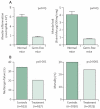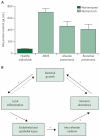The microbiome and critical illness
- PMID: 26700442
- PMCID: PMC4752077
- DOI: 10.1016/S2213-2600(15)00427-0
The microbiome and critical illness
Abstract
The central role of the microbiome in critical illness is supported by a half century of experimental and clinical study. The physiological effects of critical illness and the clinical interventions of intensive care substantially alter the microbiome. In turn, the microbiome predicts patients' susceptibility to disease, and manipulation of the microbiome has prevented or modulated critical illness in animal models and clinical trials. This Review surveys the microbial ecology of critically ill patients, presents the facts and unanswered questions surrounding gut-derived sepsis, and explores the radically altered ecosystem of the injured alveolus. The revolution in culture-independent microbiology has provided the tools needed to target the microbiome rationally for the prevention and treatment of critical illness, holding great promise to improve the acute and chronic outcomes of the critically ill.
Copyright © 2016 Elsevier Ltd. All rights reserved.
Figures




References
-
- Johanson WG, Pierce AK, Sanford JP. Changing pharyngeal bacterial flora of hospitalized patients. Emergence of gram-negative bacilli. N Engl J Med. 1969;281:1137–40. - PubMed
-
- Baas Becking LGM. Geobiologie, of Inleiding Tot de Milieukunde: Met Literatuurlijst en Ind. Van Stockum; The Hague: 1934.
Publication types
MeSH terms
Grants and funding
LinkOut - more resources
Full Text Sources
Other Literature Sources

